Murals and Mosaics in Antiquity
Jewish Art: Any cultural production that utilizes Jewish subject matter and content drawn from; 1) all material found in Jewish sacred texts and those secular texts that explore Jewish social life and history, 2) Jewish history, from Antiquity to the present, as well as Jewish ritual, music and synagogue architecture. And it begins with Dura Europos. Mosaics and Murals in Antiquity.
Jewish Art can be created by Jews and non-Jews. The essential factor in this kind of art is always the Jewish content; ideas and notions that can be called Jewish. The definition is not exclusive, rather it is flexible and changing, much as is all creativity. Jewish Art is most simply defined as the cultural expression of the Jewish people and their ideas over the millennia.
It is said that Jewish Art begins with Bezalel, the craftsman “filled with Godly spirit, with wisdom, insight and knowledge and with every craft” and his assistant, Oholiab. They crafted the utensils, decorations and furniture of the Tabernacle. They were God’s artists. But the design and artistry of the Mishkan and First and Second Temples are known to us only in texts. It has evaporated in the mists of a violent history, therefore, for us Jewish Art begins in the synagogues of late Antiquity.
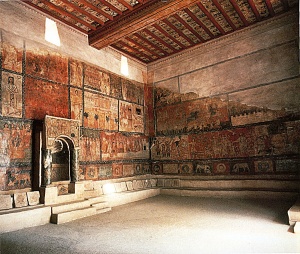
Jewish Art begins at Dura Europos [National Museum, Damascus] in 250 C.E. First uncovered in 1920-32, an extensive series of wall murals arranged in three horizontal levels on all the walls of a synagogue depicts explicit Torah narratives. On the western wall the Camp in the Desert, the consecration of the Tabernacle and the Triumph of Mordechai is seen on the left while the Exodus from Egypt, Solomon’s Temple, Moses saved from the Nile and the Anointing of David is depicted on the right. In the middle of the wall a painted Torah niche depicts the Temple, the Menorah and the Binding of Isaac. The south wall shows an Elijah Cycle, the north wall a vision of Ezekiel. Unfortunately the east wall is too fragmentary to identify. This decorated synagogue in eastern Syria along the Euphrates River is the earliest datable example of Jewish figurative representation, notably in a synagogue context. It establishes without a doubt that Jews in the third century of the Common Era produced and used visual art.
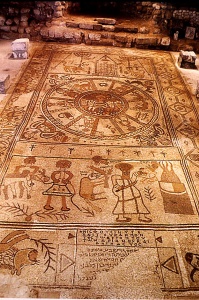
This historical fact is further reflected by the extensive mosaic floor decorations in over 50 percent of the thirty-six ancient Israeli synagogues uncovered so far. These ruins of synagogues from the early third to the sixth century of the Common Era are found from Bar’am in the north to Gaza in the south with at least ten in the upper Galilee. The enormous pavement at Hammas Tiberias (4th century) features the ark flanked by menorahs, a brilliant figurative Zodiac and personifications of the four seasons. Beth Alpha (6th century) also has an ark, menorahs, ritual objects (along with lions and birds) depicted in the mosaic near the aron. The center of the floor is dominated by an elaborate Zodiac, again surrounded by figures of the seasons. In the lower register, seen first as one would enter, is the Binding of Isaac featuring Eleazar, Ishmael, the ram caught in the bush, Abraham, Isaac and a fiery altar. This mosaic is one of the masterpieces of early Jewish Art.
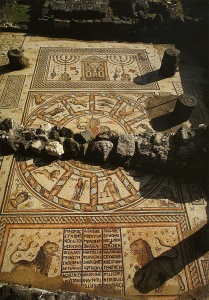
The ark flanked by menorahs, shofar and lulav is also seen in the enormous Beth She’an synagogue floor mosaic. It is a frequent motif in many ancient synagogues expresses the yearning for the Restoration of the Temple and Redemption of the Jewish people. This subject is more fully explored in the fourth century Sepphoris synagogue that includes the ark motif, the Zodiac, the consecration of Aaron, the daily offering, the showbread table and basket of first fruits (bikorim). In the next section two mosaic panels depict the Binding of Isaac and finally, nearest the entrance, the angel’s visit to Abraham and Sarah. The visual creativity of the Jews in the decoration of their synagogues from the third to the sixth century has seldom been surpassed.
Manuscripts
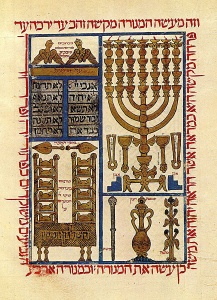
The next outpouring of Jewish artistic creativity is the illuminated manuscript. This art form flourishes for six hundred years from the tenth to sixteenth centuries, starting in the Islamic Near East and moving gradually through Western Europe. In 895 the earliest surviving example of Hebrew illumination, a Book of the Prophets by Moses ben Asher, a Masoretist from Tiberias, we find twelve pages illuminated in gold geometrical patterns with a floral center and corner spandrels. Tiny micrographic text contributes to the lush design. These highly abstract “carpet” pages, so called because the design tended to be uniform over the entire page, dominated Jewish illumination for the next hundred years. Soon illuminated Bibles (many Karaite) elaborated pure design into more concrete representations of the Tabernacle in the wilderness and its various utensils. Even more elaborate depictions of sacred vessels are found in a Bible in late 13th century Spain [Bibliotheque Nationale, Paris].
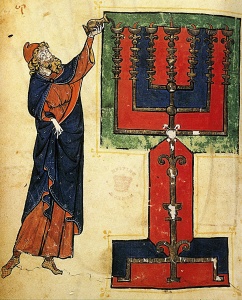
In the thirteenth century Jewish illumination begins its Golden Age, especially with the extensive production of luxurious Haggadahs. At least 73 illuminated Haggadahs created between the 13th to 16th centuries have been studied. Over twenty survive from the 14th century alone. They were created across a broad geographical area from Spain, Northern France, the Rhineland and Southern Germany and Italy.
This production in Spain of luxurious Haggadahs is in addition to many works produced in the German lands and Italy. The earliest illuminated Jewish manuscript in Germany is a two volume Rashi from 1233 [Bayrische Staatsbibliothek, Munich] with miniatures in the initial word panels for each parashah. It was quickly joined by at least twenty illuminated Bibles, Mishneh Torahs of the Rambam and many large and elaborate Mahzorim meant for public synagogue use by the chazzan. Notably, a late 13th century French illuminated Miscellany (a collection of Machzorim and other religious texts for private use) [British Library] boasts some 41 biblical miniatures.
There are many examples of Italian Renaissance Jewish illuminated manuscripts including Bibles, Tehillim, halachic and medical texts. Perhaps the most famous Italian Jewish text is the Rothschild Miscellany (15th century) [Israel Museum] that has at least three hundred textual illuminations. This art form was clearly custom made for the Jews.
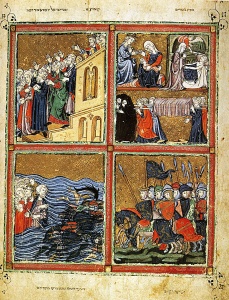
Nonetheless the Haggadah, especially those produced in 14th century Spain, triumphs in quantity and quality. The Golden Haggadah (1330) [British Library] prefaces the Haggadah text with a series of fifteen full page miniatures depicting the Biblical narrative from Adam up to the Exodus. Each page has four episodes of the narrative and explicates not only the narrative but its commentators as well, utilizing a simultaneous conflation of various aspects of the story-line. The juxtaposition of four stories on one page creates new narrative possibilities, frequently heightening the drama as in the combination of the Death of the First Born, the Jews exiting Egypt with a high hand, the Egyptian army pursuing the Jews and finally the defeat of the Egyptians at the Sea.
In contrast the Rylands Haggadah (also 14th century) [Rylands University Library, Manchester] is much more simple in its narrative and concentrates on the Passover story itself, starting with Moses at the Burning Bush, moving through each of the plagues and finally exalting in the devastation of the Egyptians at the Sea. This 14th century manuscript carries its visual enthusiasm into the Haggadah text itself with extensive illuminations, ornamented initial letter panels and embedded drolleries.
Because illuminated Jewish manuscripts were prized luxury items many survived the ravages of violence and expulsions. Synagogue decorations and ritual items such as menorahs, kiddush cups and the like have not been so fortunate. But perhaps since we so highly valued books, the next form of Jewish Art has survived, i.e. the Jewish illustrated book. We will explore them along with a rebirth of illumination and finally the 19th century birth of Jewish painting, in our next article.